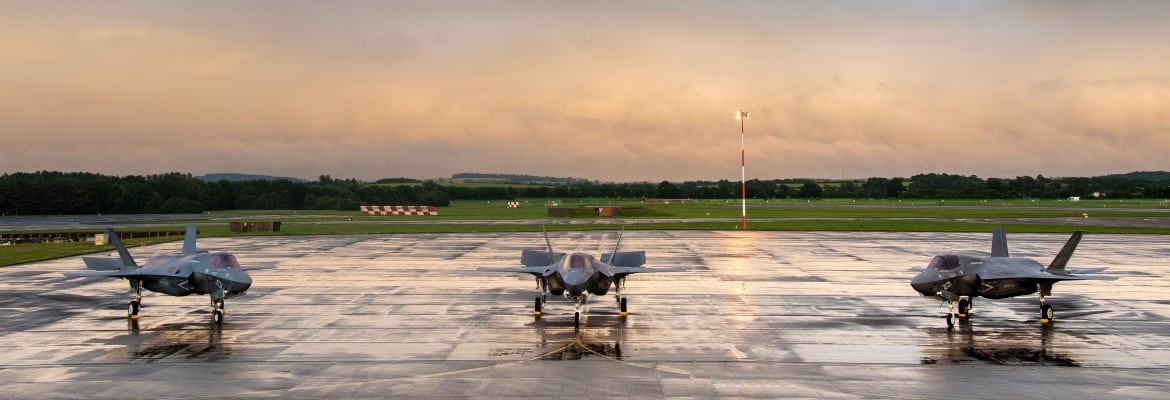 |
| F-35 Fighter Jets. Photo: Lockheed Martin |
[Avionics Magazine 09-21-2016] Thirteen F-35A Lightning II fighter jets taken out of service are beginning testing on solutions and could return to operations this year, Mark Johnson the spokesperson for Lockheed Martin, the prime contractor for the F-35, told Avionics Magazine. Peeling and crumbling insulation in avionics cooling lines moved the U.S. Air Force (USAF) to temporarily pull 13 F-35’s from flight operations on Sept. 16, although the issue spread to a total of 57 aircraft, 15 of which are currently fielded.
Maintainers doing depot modification work on an F-35A aircraft at Hill Air Force Base, discovered that insulation in cooling lines within three fuel tanks were peeling away and crumbling earlier this week.
“Subsequent tests conducted at Lockheed Martin Aeronautics indicated it was possible for this crumbling insulation to become lodged in the siphon lines connecting wing and fuselage fuel tanks. This could result in excessive negative pressures in the fuel tanks during flying operations or excessive positive pressures during air or ground refueling. In either case, the under- or over-pressure could cause structural damage to the fuel tanks,” USAF spokesperson Ann Stefanek told Avionics Magazine.
According to Stefanek, preliminary investigations suggest that an incorrect sealant was applied to the insulation. As a result, it gradually broke apart due to contact with fuel.
“Because of a misstep in process from the supplier this insulation has the potential to flake off. When that occurs inside the F-35A wing, which is a fuel tank, under extraordinary circumstances it might have the opportunity to get into the fuel and cause [Foreign Object Damage] FOD,” Johnson confirmed.
The issue raises questions about the viability of F-35s in the field, but Lockheed believes the problem is limited to a single batch of cooling lines in which non-conforming insulation was found on coolant tubing carrying Poly-Alpha-Olefin (PAO) throughout the jet’s wings.
“The issue is confined to one supplier source and one batch of parts,” Johnson said. “We know that only these aircraft have been impacted because it is a singular part identified through a part number. We know exactly which part and where it came from, so we were able to trace it to specific jets as opposed to it being a systematic problem.”
Johnson confirmed Lockheed Martin was working with the supplier to remedy the situation and would likely continue to work with them after the issue had been corrected.
Engineers at Lockheed Martin and the F-35 Joint Program Office (JPO) are addressing the issue alongside Hill AFB Airmen, the team has currently conducted inspections of at least eight aircraft. Engineers are currently developing procedures that will allow them to resolve the issue without having to replace the maintenance lines. This will hopefully get the aircraft ready for flight prior to the release of affected production aircraft to the field, and return affected operational aircraft back to the field before the end of the year.
“We won’t need to replace the cooling lines; our engineers are working on a solution and they have it,” said Johnson. “They are starting on the first test article at Fort Worth early next week. When that test article is done to the specification of the U.S. Government, JPO, etc., then eight teams from Lockheed will go into the field to provide the necessary maintenance on the aircraft in the field.
The fielded aircraft include 10 at Hill Air Force Base, Utah, four at Luke Air Force Base, Arizona — of which two belong to a partner nation — and one at Nellis Air Force Base, Nevada. An additional 42 aircraft in production are also impacted, 28 of which belong to the U.S., and 14 foreign military sales aircraft.
While Johnson was unclear on exactly how engineers would address the issue, he noted that the aircraft would be suspended from flying for the next few months but were currently on track to return to service by the end of 2016. “Our target is to have all 15 jets in the field back up and flying by the end of the year.”
This is certainly not the first issue for the F-35, which was delayed in March an extra four months on top of its long and troubled history in light of software challenges.
“While nearing completion, the F-35 is still in development and challenges are to be expected,” said the USAF in a statement released on Sept. 16.
As of now, the USAF is working to mitigate the impact on F-35 operations, training and readiness, and programmed flight training and other impacts will depend on the number and timing of aircraft returned to service.